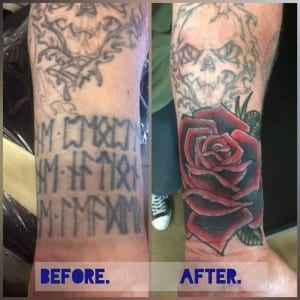Erase the Hate: Don’t Let the Ink Define You
By Harrison Heller
HBO has a fairly new documentary series titled VICE. Each hour-long episode features 1 or 2 stories that do not get much coverage in the mainstream news. Their most notable episode was their report on the ‘Unite the Right’ march in Charlottesville, VA. This event brought America’s ugly side back to the surface with torch carrying white supremacists and neo-Nazis chanting “Blood and soil,” “white lives matter,” and “Jews will not replace us,” as well as the reemergence of David Duke and the Ku Klux Klan.
Since the events in Charlottesville, there have been two high-profile anti-Semitic attacks, the attack at the Tree of Life Synagogue in Pittsburgh, PA and the attack at the Chabad in Poway, CA. Two African Americans were gunned down outside a Kroger grocery store after the shooter attempted to get into an African American church in Louisville, KY. In a ten-day span, three African American churches were burned down in Louisiana. According to the Southern Poverty Law Center (SPLC), 40 people died at the hands of “alt-right killers” in 2018, compared to 17 in 2017. As of 2018, the SPLC has tracked a record high 1,020 hate groups operating in the United States. This is the fourth straight year with a 30% increase.
 There are some people in these groups who experience a change of heart and realize that hate leads you down an even darker path, and they want to escape. TM Garret, a former skinhead and Klansman, said, “Hate is a fulltime job. 24/7 paranoia.” Some of these people have literally worn their hate and ideology on their sleeves and bare them on their hearts. Romey Muns, a former member of the Aryan Brotherhood, said, “Seeing all the hate tattoos I have on me…it’s embarrassing.”
There are some people in these groups who experience a change of heart and realize that hate leads you down an even darker path, and they want to escape. TM Garret, a former skinhead and Klansman, said, “Hate is a fulltime job. 24/7 paranoia.” Some of these people have literally worn their hate and ideology on their sleeves and bare them on their hearts. Romey Muns, a former member of the Aryan Brotherhood, said, “Seeing all the hate tattoos I have on me…it’s embarrassing.”
In early May, I came across a YouTube video from Vice entitled Covering Up Racist Tattoos: Erasing the Hate. The video featured the story of a campaign called “Erase the Hate” that provides free tattoo cover-ups for former gang members and hate/extremist group members. The program was started by TM Garret in August 2017 at Sickside Tattoos in Horn Lake, MS. Since the program started, they have expanded to several studios in 6 states and have given cover-ups to 100-150 people.
Approximately 70% are gang tattoo cover-ups and 30% are hate tattoo cover-ups. Upon viewing this video, I reached out to TM and Sickside Tattoos about wanting to learn more about this program. One of JWV’s cornerstones is to combat anti-Semitism and hate, and this is a real-life example of that and the ultimate change of heart, as well as a true second chance. I heard back from TM almost instantaneously. He and I arranged a night where we could talk about his experience and learn more about the “Erase the Hate” campaign. Everything in TM’s life was a lead-up to this campaign and prepared him to become the leader and champion for those wanting to escape the movement.
The way most people get involved with hate/extremist groups is falling into a cycle of validating beliefs, rooted in fear and distrust, and finding likeminded people. This is no different than TM’s story. I wanted to learn more about the “Erase the Hate” campaign, and in order to learn that, I had to know the inspiration, the spark that lit the fire and became a beacon of hope to escape.
During our conversation, TM told me the story of how he got involved in the white supremacist movement and how he rose through the ranks. TM was born and raised in small, conservative town in southern Germany of approximately 500 people. As he was growing up he described himself as a bit of a loner and was constantly bullied. He eventually found a way to get the attention he so craved, and that was through telling racist and anti-Semitic jokes with a group of several kids. TM got a sense of gratification, so he kept on telling jokes. Through the attention that the jokes gave him, he became known as the “Nazi Kid.” He hated the nickname and hated the label, but the bullying suddenly stopped.
In middle school he was handed a tape from a friend that had hard rock music. The music featured lyrics and themes that were very familiar to TM. Themes of being misunderstood, being Nazis “but they weren’t,” and nationalism. With each new tape he received, the music became harder, and messages became more of white supremacy and hate. At the same time, he started taking on the image of a skinhead. TM became self-radicalized through the music and was indoctrinated by age 15. In 1997 he formed a band that featured music about pride, saving the country, saving the white race, and wanting to ban immigrants and “kick out all the foreigners.” The only black person he knew at the time was an African American girl, whose father was an American serviceman stationed in Germany. That was when he heard the N-word the very first time – out of the mouth of the same kid who gave TM the cassette tape.
In the late 1990’s TM was asked to join a German Ku Klux Klan group, but it was not what he had expected. The internet became a huge recruiting tool for white supremacist groups and allowed them to communicate with ease. As TM’s doubts about the group grew, he was encouraged by a klavern in Mississippi to open a new KKK group in Germany.
In 2000, he flew to Mississippi and was inducted at a cross-burning ceremony. He flew back home as the Grand Dragon for the Realm of Germany and Imperial Representative for Europe. TM was convinced that, “it was not about hate, it was about love for our own race. But at the end, it was about hate.”
As we spoke about the ideology of the German KKK, TM told me that the German far-right was more Pagan, a person “can’t be anti-Semitic and Christian at the same time. Jesus was Jewish.” He told me that the blood drop in the middle of the KKK emblem represented the blood of Jesus Christ, and this whole concept confused him. For TM, the identity part became much more important in his new group and the racism became far less important. This caused a lot of infighting within the new organization, between TM and other members.
In the Fall of 2002 the police and government began to knock on the doors of members, and informed them they were being investigated. TM contacted a trusted member and told him that he was resigning and that he wanted to disconnect. TM and his family moved about 100 miles away, where they rented a place owned by a Turkish Muslim landlord.
After settling-in, TM was asked by the landlord if he could help him with some IT work. TM was broke and looking for work, so he accepted the offer. Several months prior, he says that he would have never taken the job. Since the job was taking longer than expected, the landlord made some Turkish tea and pancakes. TM refused at first because maybe he touched the food. He later thought that it could be rude in the Turkish culture to refuse the food. He believed that if he refused, that the landlord would turn into a Muslim terrorist or something horrible would happen. So, he took a bite and a cup of tea. This went on for months and months. TM later decided to not take the money, he wanted to help and be a good neighbor.
One day, the landlord invited TM over for dinner with his family. It was baked chicken, oven fries, and fish soup. TM laughed and told me that he hates fish soup. The fish soup was put in front of him, and he paused. He was afraid to reject the food, as judgmental thoughts raced through his mind. He built up the courage and said to his landlord, “I can’t eat it. I don’t like fish soup.” The landlord’s wife smiled, took it away, and brought him some chicken. TM was amazed and tried to comprehend what happened. “What had just happened here? I was sitting here so judgmental expecting the bad stereotypical reaction that I was taught, and it did not happen.”
In 2012, TM was 10 years removed from the white supremacist movement and he had moved to Memphis, TN. There he opened a music studio. In 2016, TM became involved in civil and human rights. It was the time when police brutality hit the media and Black Lives Matter was launched. TM realized that there was still a gap between the black and white communities, and everybody was now protesting. After the protests, everybody would go home and think they’ve done enough. He did not agree and thought more must be done to bridge “gaps that were created by racism, ignorance, and hate.” As part of these initiatives, TM started the non-profit C.H.A.N.G.E (Care, Hope, Awareness, Need, Give, Education), along with Pastor Ray Johnson, a former member of the Bloods street gang.
In 2017, TM paired-up with Sickside Tattoo Studio shop manager, Drew Darby, and owner, Jack Flores, to form Erase the Hate. TM once had a strong desire to remove the tattoos that reminded him of his past, and the people at Sickside knew other people in TM’s position. They now work together to combat hate and help those who are trying to erase their past by providing gang and racist tattoo cover-ups for free.
On May 3, 2018, TM was featured in a short film by Chapman University titled, Rewired. The film tells this same story of TM’s journey in the white supremacist movement. He was invited to the screening at the university after which he visited the Museum of Tolerance in Los Angeles. After visiting a full-size replica of a gas chamber from a Nazi concentration camp, he decided he wanted to interact more with the Jewish community. He soon became involved with the Simon Wiesenthal Center, where he continues to speak. After the largest anti-Semitic attack in United States history at the Tree of Life Synagogue, in Pittsburgh, PA, this cemented his further involvement with the Jewish community. Later this year, TM will be speaking at Alpha Epsilon Pi’s 106th Convention in Alexandria, VA, during a pre-convention session on the Tikun Olam track. He has also spoken at multiple Jewish day schools.
At the end of our conversation, TM told me his birth name, Achim. A former skinhead and Klansman was born with a Hebrew name.
If you know anyone, or if a friend or family member knows anyone, who is trying to escape the white supremacist movement or a street gang, please contact TM Garret at info@changememphis.org or text 662.671.2470 to get help.
To learn more about TM, the Erase the Hate campaign, and to see videos about the program, visit www.tmgarret.com
Volume 73. Number 2. 2019




